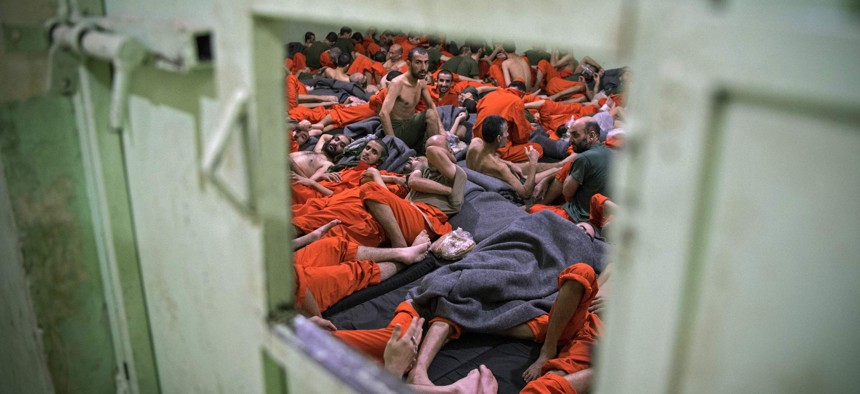
Men, suspected of being affiliated with the Islamic State (IS) group, gather in a prison cell in the northeastern Syrian city of Hasakeh on October 26, 2019. FADEL SENNA/AFP via Getty Images
Coalition Plans To Expand Giant ISIS Prison In Syria
The UK-funded effort signals no answer in sight to the thousands of foreign and Syrian detainees.
AT A COALITION MILITARY BASE IN NORTHEAST SYRIA — The U.S.-led anti-ISIS coalition is funding a dramatic expansion of a large detention facility in northeastern Syria, a move that may reduce the chance of breakouts but which signals that no better way is in sight to deal with captured foreign and local militants.
The effort will double in size the current facility at Hasakah, a series of three converted school buildings that holds roughly 5,000 prisoners, according to British Army Maj. Gen. Kevin Copsey, the coalition’s deputy commander for strategy.
The makeshift prisons are operated by America’s Kurdish partners, the coalition-backed Syrian Democratic Forces, or SDF. The international coalition has over the years offered funding and support to harden their security. A British Ministry of Defense spokesperson confirmed that the U.K. is funding the Hasakah effort, which Copsey called “quite a significant expansion.” Once completed, the now-crowded and crumbling facility will meet Red Cross standards, Copsey said.
Military officials have warned since the fall of ISIS’s territorial caliphate in 2017 that the SDF would not be able to maintain the prisons indefinitely, and that experienced fighters could break out from the ramshackle facilities and return to the battlefield. But the coalition appears to have no better solution than to shore up Hasakah, which is overcrowded and effectively run by inmates internally.
“We acknowledge that ISIS primarily in this region are sent to that institution,” Copsey said.
The goal, said Lt. Gen. Paul Calvert, the commander of the U.S.-led mission, is to allow the SDF to gain better control of the facilities internally. Right now, although the SDF do occasionally go inside the prison to conduct sweeps for cell phones and other contraband, the density of inmates compared to prison guards makes such operations risky and relatively rare.
“What [the expansion] affords them to do is to really spread [the prisoners] out a little more so you don't have the networks that are building inside of the facilities,” Calvert said in an interview at coalition headquarters in Baghdad on Friday.
The Ministry of Defense spokesperson said in a statement that the effort included “technical advice and funding for the refurbishment and expansion” of the facility “as part of the Global Coalition’s collective stabilisation efforts in the region.”
Although this particular expansion effort is funded by the U.K., the United States also has a budget for security improvements to the prison facilities, primarily targeted at hardening the external perimeter security and intelligence, Calvert said.
“There are also some things that we can do that affords us the opportunity to better understand the networks inside of the facilities,” he said. “The better we can understand the networks inside of the facilities and what external linkages they have, the better we are able to use that as a means to drive targeting and against those that are external to the process.”
A U.S. military official said there is some surveillance within the prisons, including listening devices, monitoring cell phone usage, and CCTVs.
In the prisons, President Biden has inherited a problem that bedeviled his predecessor. Senior officials have been grappling with what to do with the roughly 12,000 prisoners in SDF custody for years, with little luck. Most are from either Iraq or Syria, but about 2,000 are so-called “foreign fighters,” the group that U.S. officials say present the biggest problem. America has had little luck pressing European allies — including the U.K. — to take back and try those fighters in their own courts. Britain has stripped British ISIS fighters of their citizenship and the United States in October charged two British-born ISIS fighters in its own courts.
The expansion effort “demonstrates the limits of what the coalition can do,” the U.K.’s Copsey said. “We can fund infrastructure for detainees, we can provide nonlethal systems for the SDF to administer these facilities and we can use our presence and our connectivity to try and pull various international organizations together — and indeed amplify it into the international community so that they can agree amongst themselves an enduring solution to the problem.”
Calvert had a different answer: “Really, what we want is we want repatriation of those that are being detained back to the countries from which they came.”
It was not immediately clear whether there are foreign fighters currently held at Hasakah, or only fighters from Syria and Iraq. The facility has housed at least some foreign fighters in the past, according to a former official familiar with the issue.
Local fighters, too, are a challenge. The body that holds them — the SDF — is not an internationally-recognized government, making a valid court system impossible. Some have been tried in Iraqi courts, but those slap-dash trials have been criticized for due process failures.
The coalition has successfully retaken the physical territory once held by ISIS, and military officials say that what remains of the organization is far less effective. A recent suicide bombing in the heart of Baghdad was the result of “three to four months worth of effort, in terms of setting the conditions to be able to pull that off,” Calvert said.
But a simmering low-level insurgency in both Iraq and Syria remains, Calvert and others emphasized. In Syria, Calvert said, he is particularly concerned about ISIS activity in the regime-controlled Badia Desert, where the United States does not have a presence.
“If there was an opportunity [for ISIS] to reemerge, I think the Badia becomes a focal point for that,” Calvert said.
A separate but no less troubling problem is the roughly 65,000 women and children held in a displaced persons camp known as al Hol, in the northeast of Syria. Humanitarian conditions at al Hol are dire, and military officials are deeply concerned about the radicalization of those trapped there. Of particular concern, Calvert and Copsey said, are the ISIS wives who are working to build networks and spread the group’s violent ideology.
“It's that rather than the detainees that is becoming our biggest worry at the moment,” Copsey said.
A huge proportion of the 65,000 people living at al Hol are children, with two-thirds under the age of 18 and over half under the age of 12, Calvert said. The wives of ISIS fighters are carrying out a daily indoctrination program, he said, and so-called “cubs” are “exported back through the rat lines coming out of al Hol that pushes them down into the Badia desert for additional training and use as [ISIS] fighters.”
There is also weapons smuggling in and out of the facility, Calvert said.
At Hasakah, there is also a female-only prison and a youth rehabilitation facility that have already been enhanced with coalition money, Copsey said, primarily in the form of clean water, sanitation and medical supplies.
“I think that probably sets an example of what the future could be, which is more facilities like that,” Copsey said.
According to Copsey, the coalition is also exploring funding the construction of a youth rehabilitation center that could take up to five hundred youth “as a good way to disengage them away from the ISIS perpetrators in al Hol,” he said, as well as more female detention centers, “so that you could attack deradicalization in small bite sized chunks rather than in the large swathes of al Hol camp.”
Calvert called on the international community to ramp up deradicalization efforts. He suggested that such programs could be developed within the prison facilities also, in particular to target the younger men still in their teens and early 20s that SDF has “tried to separate out from the older population.”
“You could probably make a lot of gains if you had a very focused program that would develop job skills and help them to see something other than the [ISIS] mindset of how they view the world,” Calvert said.
But in the end, both Calvert and Copsey said, the military’s toolkit remains fairly limited. The problem, ultimately, is a political and humanitarian one, not a military one. For Calvert, the most immediate problem is securing the facilities themselves.
“If you have a breakout up there, that's instant combat power that immediately goes back into the Daesh organization and they're ready, willing and able to fight and still are committed to that fight,” Calvert said.
